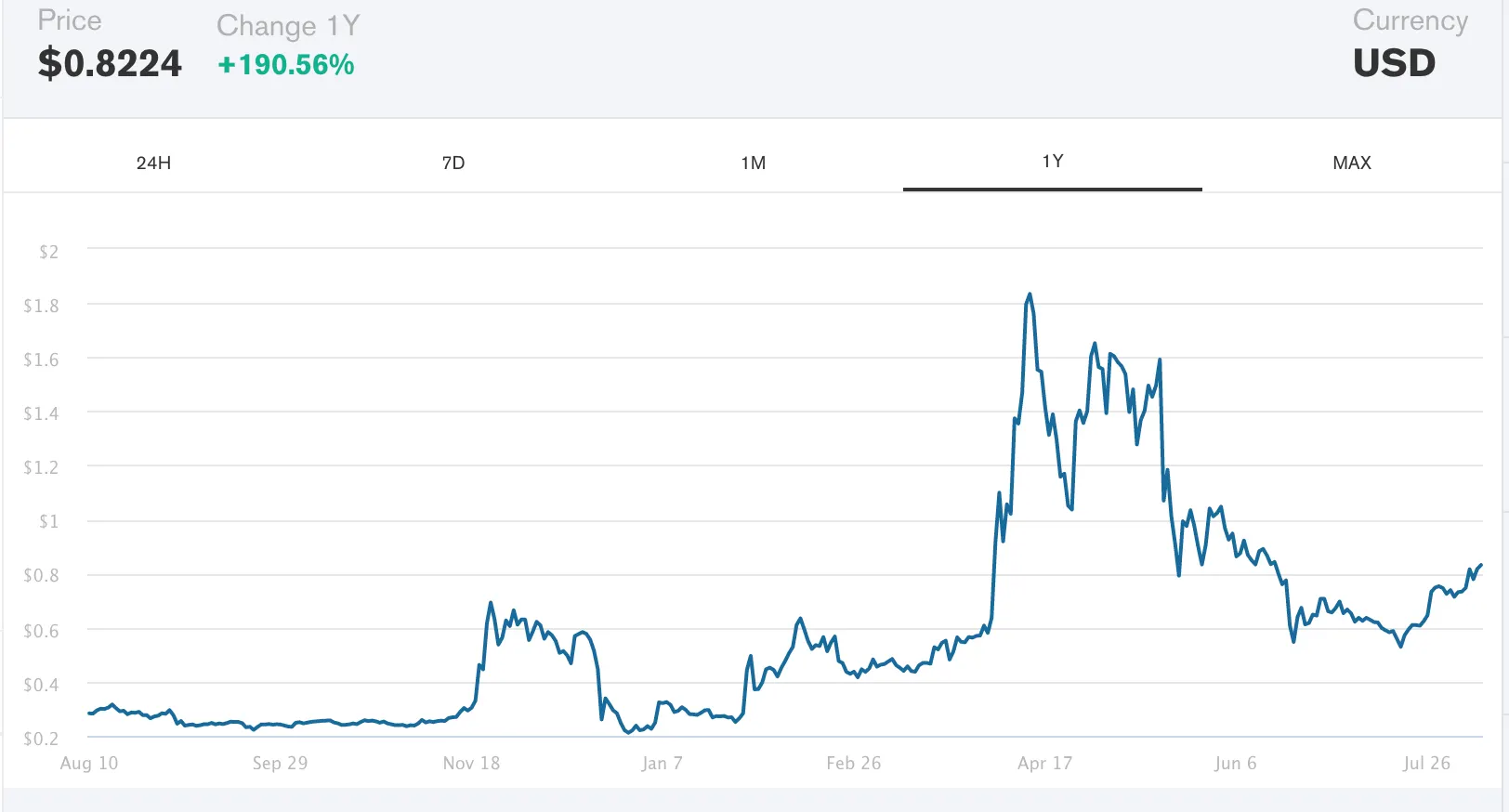In brief
- An investigation reveals Ripple is on a limb—but so is the SEC
- A loss for Ripple could mean losing its XRP, while an SEC loss would erode its credibility
- Most lawyers believe the SEC has the upper hand, but are not confident it will win
It was a bad start to Christmas. Brad Garlinghouse and Chris Larsen’s digital currency company Ripple had been riding high in 2020 amid the first crypto bull market in years. Then, on December 22, the lawsuit dropped.
In a scorching complaint, the Securities and Exchange Commission said that Ripple Labs—which Larsen and Garlinghouse tout as the future of banking—had broken the law by selling unregistered securities. The fallout came quickly. News of the SEC suit torched half of the $28 billion market value of XRP, the cryptocurrency closely tied to Ripple. Crypto exchanges rushed to boot XRP off their platforms. The SEC lawsuit also muddied Ripple’s reputation.
“It was a rough holiday for sure,” says Garlinghouse. “I’ve always viewed myself as one of the good guys in Silicon Valley who does what’s right—only to have the U.S government assert in an inflammatory way you’re playing dirty.”
For years Ripple occupied the number three spot in the cryptocurrency market, right behind Bitcoin and Ethereum. The company had built relationships with major banks and amassed an army of devoted followers. Now, the SEC threatened to unravel those achievements with some uncomfortable questions: Was Ripple no more than a glorified scam? Were Larsen and Garlinghouse’s lofty claims about XRP just a pretext to line their own pockets?
The cryptocurrency world, including the thousands of small investors who hold XRP, will soon find out as the case barrels towards a trial.
Ripple, meanwhile, has adopted an unusual strategy—sparring publicly with the SEC rather than quietly settling, which is what most firms in its situation would do. The company has also hired elite legal talent, including the former head of the very agency it is battling. It pledges to fight the case right to the Supreme Court.
For the SEC, the Ripple case is a test of strength. If the agency wins, its victory will spell trouble for many other crypto companies. If it loses, the outcome will mean humiliation for America’s top financial cop and the erosion of its enforcement powers.
In more than a dozen interviews, people close to Ripple and experts in securities law described SEC v Ripple as a case that will not only decide the fate of the company, but shape the future of the crypto industry by determining whether cryptocurrencies should be treated like stocks. A judge could answer that question as soon as this fall. Billions of dollars are riding on the answer.
Born in the Bitcoin era
Originally named OpenCoin, Ripple was founded by a group of programmers, including Jed McCaleb. A crypto pioneer, McCaleb also created the cryptocurrency Stellar and Mt. Gox, which grew into the world’s largest Bitcoin exchange before it collapsed amid a catastrophic hack under a subsequent owner. McCaleb's team founded the precursor to Ripple in 2011 and Larsen, a wealthy entrepreneur, joined soon after.
In 2012, the team created a company called Ripple Labs, and bequeathed it a digital currency named XRP (originally “ripples”). Unlike Bitcoin and Ethereum, which are minted slowly over time, XRP doesn’t depend on miners to create and distribute its tokens. Instead, the Ripple founders created the entire supply of XRP—100 billion of them—in one fell swoop.
XRP has a blockchain ledger to track who owns the supply but no one has minted a new token since 2012. Shortly after the currency began trading, speculators came to view it as a potential rival to Bitcoin and began to bid up its value.
All of this presented the Ripple founders with a conundrum: How to persuade people of a real world need for the 100 billion XRP they spun into existence?
The two biggest cryptocurrencies have addressed this problem. In the case of Bitcoin, it enjoys a special place as the original crypto, and its relative scarcity—there will only ever be 21 million Bitcoins—has made it a store of value that its fans liken to “digital gold.” On Ethereum, meanwhile, millions of users pay to use its currency as “gas” to power smart contract transactions.
The purpose of XRP is less clear. Like other tokens, XRP is tracked on a blockchain ledger with software nodes around the world that validate its transactions. The ledger, which is versatile and built by top cryptographers, is highly regarded in the industry. Even XRP skeptics such as crypto analyst Ryan Selkis, who labelled the currency “toxic waste” in his widely-read annual report, praise the ledger itself.
The challenge for Ripple, which still owns the bulk of those 100 billion XRP, is to show that all those tokens are good for, well, something.
Ripple has tried for years to do just this. Its efforts include a 2015 push to persuade banks to pay XRP transaction fees while conducting money transfers on the XRP ledger. This proved a non-starter, though, as the banks made clear they liked the ledger but not XRP. Ripple responded by creating a new ledger product called xCurrent that was similar to the original one that let banks send messages and transfer money—but that did not require XRP.
Ironically, xCurrent may be Ripple’s most successful product to date, bringing in over $23 million, and positioning the company to succeed as a conventional SaaS (software-as-a-service) firm. But that did not solve the problem of creating a market for the billions of XRP sitting on Ripple’s digital shelves.
So the company shifted to a kitchen sink approach. After it failed to persuade banks to use XRP, a former employee recalls that Ripple began exploring a wide variety of possible use cases for the currency, including an XRP card customers could use at gas stations. Ripple denies the gas card anecdote but it's clear the company at this time was trying to find some use for all that XRP.
This challenge facing Ripple—how to find a market for a novel product—is the sort of thing one might encounter in a business school case study. So the Ripple board turned to its then-COO, Brad Garlinghouse, to solve it.
Trim and energetic with a closely-cropped beard, Garlinghouse is a Harvard Business School grad and well-known Silicon Valley figure with a streak of eccentricity. He is famous in valley circles for “the peanut butter memo”—a document he wrote while an executive at Yahoo. The memo, which was leaked and shared widely in tech circles, used condiment metaphors to argue (correctly, it turns out) that the company had spread itself too thin.

Upon being tapped for the top job at Ripple in late 2016, Garlinghouse made the same diagnosis as he had at Yahoo: Ripple needed one killer use case rather than dozens of experimental ones. The solution he landed upon was pitching XRP to banks and others as a “bridge currency” to facilitate global money transfers between smaller national currencies.
According to Garlinghouse’s “bridge” thesis, banks would embrace XRP for international transfers because it would eliminate the need to maintain reserves of minor currencies like the Philippine peso—reserves that tied up the banks’ capital. To carry out the plan, Ripple persuaded a network of money transmitters to deal in XRP, meaning the banks themselves would only need to hold the currency momentarily. All of this activity would, in theory, increase liquidity and drive up the price of XRP.
It was a complicated plan. To spur it along, Larsen and Garlinghouse negotiated deals with large global banks such as Santander and money transfer shops like MoneyGram. Ripple even bought a 10% stake in MoneyGram to encourage the company to use XRP in its operations.
The bridge currency initiative involved another new product named xRapid, later xVia, that behaved like xCurrent but also facilitated the transfer of XRP. (The distinction between the various "x" products has been an ongoing source of confusion for many outside the company).
Meanwhile, Ripple took on the trappings of a major financial company. It moved its headquarters to a stone building near the Bank of America pyramid in San Francisco’s financial district, and opened offices in global money centers, including London and Singapore. It sponsored swanky conferences and hired entertainers like Snoop Dogg. One evening in Toronto, hundreds of Ripple guests nibbled satays and sipped Scotch while aging rock legend Steve Miller grinded out “The Joker” and other hits.
All of this helped spur XRP to new heights. Whether due to Garlinghouse’s efforts or the broader 2017 crypto bubble (or most likely both), the price of XRP galloped from less than a penny in 2016 to $3 in January of 2018.
By this time, Ripple looked and acted like a big bank. Garlinghouse did his best to promote that image, appearing at serious finance events and on TV in elegant grey suits. The company still struggled to make a viable case for XRP but it was trying hard.
Unfortunately for Ripple, the SEC didn’t view the company this way at all. What the agency saw instead was a massive grift—a stock swindle that used fancy finance trappings to snooker suckers into buying XRP. The SEC sued on December 22, dropping the hammer on Ripple and taking the unusual step of naming Larsen and Garlinghouse as defendants. The agency alleged the two men and their company had made billions by unloading unlicensed securities onto the public.
The SEC complaint caused the price of XRP to tumble from around 58 cents to 21 cents in late December, though it has more than rebounded since amid a banner year for crypto overall.

The Case against Ripple: Execs talked up XRP while quietly selling billions of it
Larsen is pale and soft-spoken but projects a quiet intensity. After the SEC charges dropped right before Christmas, he took long walks in San Francisco’s sweeping Presidio district and brooded.
“It felt terrible, like a gut punch. I thought ‘come on guys we’re an American company’,” says Larsen, grimacing as he recalls telling his children that he was a defendant in a lawsuit splashed across the front pages of the business press.
Garlinghouse says the lawsuit left him dismayed but also puzzled. The SEC filed the allegations in the waning days of the Trump Administration and, days later, both the agency’s chairman, Jay Clayton and top enforcement official Marc Berger announced they would leave their jobs early. Garlinghouse recalls asking himself, “Is this personal in some way?”
Both Larsen and Garlinghouse convey a sense of bafflement and sorrow about the SEC lawsuit, but it can hardly have come as a major surprise. The agency had been investigating Ripple since 2017, and its executives were subject to a litigation hold—forcing them to preserve emails and other documents—for years. Legal experts believe the SEC’s decision to drop the lawsuit reflected less a bolt-out-of-the-blue decision than a refusal by Ripple to accept the terms of a settlement proposed by the agency.
As for Larsen and Garlinghouse, both men possess a pugnacious streak they conceal beneath a genial demeanor. Larsen, for instance, has paid to install surveillance cameras across his hometown of San Francisco—a move decried by civil liberties advocates, but applauded by those who say the city’s political class has failed to address rampant property crime. Garlinghouse, while always sunny in public, can flash a hot temper in private, employees say, and he has travelled with former U.S. Special Forces troops as bodyguards. (Such security precautions are not uncommon among crypto executives who have been the target of kidnapping plots).

The company they run has not been shy about protecting its interests. When executives leave Ripple, they receive fat severance packages but must sign fearsome NDAs in return. This tactic makes it difficult for reporters and others to divine what is actually happening inside Ripple.
The SEC, however, has made clear what it thinks Ripple is all about. Some of its allegations are damning. In a 70-page complaint filed in Manhattan federal court, the agency claims that Ripple’s corporate trappings serve as a façade for its real agenda: flogging highly speculative XRP tokens that, in the interests of the public, should have been registered as securities.
In its complaint, the SEC suggests the only reason money transmitters are using XRP as a “bridge currency” is because Ripple paid them to do so. This applies to MoneyGram, the money transfer giant Ripple partially owned, and which was briefly a linchpin for its “bridge strategy”—though Garlinghouse told CNN no quid pro quo exists.
“When MoneyGram is moving money from U.S. dollar to Mexican peso, they’re buying [XRP] at market. There’s no special sweetheart deal there,” Garlinghouse told CNN. The SEC complaint says this is not true, noting that Ripple gave over 200 million XRPs to MoneyGram, most of which the company dumped on the day it received them. Ripple and MoneyGram severed ties in March.
Twisting the knife, the SEC also paints Ripple’s overall bridge currency strategy as a flop, noting that only 15 money transmitters and no banks signed on, and that in the space of two years, “bridge” transactions never accounted for more than 1.6% of XRP’s total volume.
All this time, says the SEC, Ripple was force-feeding XRP into the market through quiet deals with large trading firms such as Jump Capital and Galaxy Capital. Under the terms of these deals, Ripple would sell XRP from its reserve at 4% to 30% discounts, allowing the buyers to promptly offload their purchases on the open market for a guaranteed profit. On some occasions, says the SEC, Ripple would ask a trading firm to time its XRP buy orders to coincide with its corporate announcements.
Meanwhile, Ripple also tried to use direct cash payments to get other firms to use XRP. In an email to the Winklevoss twins, who founded the exchange Gemini, a Ripple executive, copying Garlinghouse, wrote “Does a $1M cash payment move the needle for a Q3 listing?” (Gemini declined the offer).
In response to whether the allegations are true, Ripple referred Decrypt to its reply in the SEC case. The reply includes broad-based denials but not specific ones concerning its campaigns to pay partners to use XRP.
The upshot is the SEC believes Ripple pursued a cynical plan to manufacture demand for the XRP on which the company depends almost entirely for its revenue. Then there are the allegations against Larsen and Garlinghouse, which are especially withering.
In the case of Larsen, the SEC notes he quietly unloaded $450 million worth of XRP and, in an additional swipe, observes that his previous company landed in hot water over the sale of unlicensed securities. The agency’s depiction of Garlinghouse is even less flattering.
“While he was selling millions of XRP, Garlinghouse frequently told investors that he was invested in XRP, and that he was bullish on the investment … he also encouraged investors to be patient and look at the price of XRP on a longer time horizon,” the complaints states.
It also cites a public declaration by Garlinghouse, who has pocketed $150 million by selling XRP, that he is “very, very, very long XRP … I’m on the HODL side.” (HODL is crypto slang for those who hold onto a favorite cryptocurrency, come what may.)
Decrypt asked Garlinghouse how he could justify telling the public he was “very, very, very long XRP” even as he sold large amounts of it. He replied that being “long” doesn’t preclude a person from selling a portion of their holdings, and that CEOs regularly sell shares of the companies they run. Garlinghouse added he had sold only a “very small percentage” of his XRP stash.
Whatever you think of Garlinghouse’s explanation, or of Ripple’s behavior, the SEC complaint makes a forceful case that the company and its executives have been less than forthcoming about their dealings with XRP.
But Garlinghouse and Larsen aren’t the only ones who face hard questions. The agency pursuing them also has explaining to do.

The Case Against the SEC: Revolving doors and “on the fly” legal tests at the SEC
The SEC is one of the most sophisticated agencies in Washington, tasked with regulating a financial sector of staggering complexity. Even though many of the companies it oversees possess wealth and technology that far exceed what a government agency can muster, it has mostly held its own.
The SEC relies on a team of securities lawyers, economists and, increasingly, software experts who help it track the activities of high frequency traders, pump-and-dump schemers and hustlers of all stripes. But when it came to crypto, the SEC was late to the game.
Until mid-2017, the SEC stood on the sidelines as so-called initial coin offerings (ICOs) fueled one of the largest financial bubbles in history. ICOs let companies raise funds, much as they would from an IPO, but instead of distributing shares, they distribute digital tokens to their backers instead.
In theory, people who buy tokens distributed in an ICO can use them to participate in a future blockchain project. And indeed that’s what occurred in some ICOs, including the one for Ethereum which lets users employ its tokens as “gas” to carry out various tasks. But in the case of most other ICOs, the blockchains have yet to be finished due to technical difficulties or poor leadership. Or because they were outright scams in the first place.
By 2017, scams—or projects that bordered on scams—had sucked up billions of dollars from ordinary investors hoping to get in on the “next Bitcoin.” In August of that year, the SEC finally took action by issuing a report that concluded a 2015 blockchain-based investment project known as the DAO was a securities offering. While the report stated the SEC would take no action against the DAO organizers, the document was a warning shot to the broader crypto industry, saying in essence “knock off this ICO stuff or we’ll come after you.”
And that’s what the SEC did. In early 2018, the agency announced settlements against two minor league crypto projects. Then it moved up the food chain. In 2019, the SEC forced two popular messaging platforms, Kik and Telegram, to disgorge money they earned from ICO projects, and laid out its reasons in court-approved settlements.
According to Peter Fox, a securities lawyer versed in crypto cases, the Kik and Telegram settlements served as ammunition for an even bigger target: Ripple. Fox says it’s no coincidence the SEC chose the same court and team of attorneys for all three cases.
Preston Byrne, a partner at the crypto law firm Anderson Kill, agrees with the assessment that the Kik and Telegram cases were just a warm-up for the SEC. “This explains why the SEC waited to go after Ripple,” he says. “The case was so big they needed other rulings from the Southern District of New York to solidify their legal position.”
By 2019, the SEC believed it had the legal precedent to force Ripple into a settlement. But still the company refused—a stance Ripple’s defenders view as principled and courageous, and its detractors claim is a stunt to keep selling XRP for a while longer.
Whatever Ripple’s motivations, the SEC finally sued on December 22—a date that’s notable not only for its proximity to Christmas, but because the SEC chair and other key decision makers at the agency were on the way out.
“When it takes that long to figure out a case, you shouldn’t be bringing it. It’s not something I would do walking out the door,” says former SEC Chair Mary Jo White.
Small and charismatic with a mop of short grey hair, White is a formidable figure in U.S. legal circles. In addition to a successful tenure at the SEC, she was the U.S. Attorney for the Southern District of New York—a job that entailed prosecuting high profile cases involving terrorism and white collar crime, and made famous by Paul Giamatti in the HBO Series Billions.

Today, White is just one of many gold-plated lawyers working for Ripple. According to American Banker, Ripple has retained more than two dozen prominent lawyers for its defense while Larsen and Garlinghouse have retained at least six each from white shoe firms where top attorneys can charge $2,000 an hour. As for the SEC, it has seven lawyers on the Ripple case.
It’s unclear for now how much all this legal firepower will help Ripple. Steven Palley, a crypto attorney with Anderson Kill is skeptical.
“Hiring Mary Jo White is meaningless—it just means they have a lot of money,” says Palley. “You can hire fancy law firms, and you can leak things from hearings … but the law is the law.”
White’s role as Ripple’s counsel means her views of the case are hardly objective, but her comments about the timing of the SEC’s lawsuit are on point. Unlike Kik or Telegram, which sold tokens in 2017 and 2018, Ripple conducted its initial sale in 2012—well before the SEC’s DAO report warning shot, and before Ethereum (which the agency says is not a security) even existed.
Josh Mitts, a securities law professor at Columbia university who is unaffiliated with either side, questions the SEC’s judgment in waiting so long to sue.
“This is a huge drag on innovation. If you’re trying to invent something and seven years from now it could lead to a prosecution, that will create a huge chilling effect,” he says.
The SEC’s eight-year delay in suing Ripple raises questions of fairness, but the agency has justified the delay by framing the company’s behavior as a rolling ICO—treating its recent XRP sales as part of an ongoing decision to violate securities law. According to White, this legal theory “doesn’t fit” and “sticks in your craw.”
The agency, meanwhile, is in an uncomfortable position over its inconsistency in handling other high profile blockchain offerings. Those include EOS, which raised a mind-boggling $4 billion in an ICO that ran from 2017 to 2018 and whose marketing included billboards on Times Square. The project has since been dogged by controversy, including over its centralized attributes, but the SEC nonetheless let EOS off the hook in return for a $24 million fine—a paltry amount given its size, and one that left many lawyers incredulous.
The agency has also raised eyebrows over its dealings with Ethereum. In 2018, a senior official at the agency gave a speech saying the sale of ETH tokens did not constitute a securities violation because the project had become “sufficiently decentralized.” In other words, those who launched Ethereum violated securities law until they didn’t—raising the question of why other projects, including Ripple, can’t do the same. Meanwhile, the SEC has failed to provide guidance on how or when something crosses the “decentralization” bar.
The SEC’s Ethereum decision received cheers in crypto circles. But it puzzled many lawyers since the decision glossed over a 1946 Supreme Court test known as Howey that is the bedrock of modern securities law, and has been applied in business transactions involving everything from orange groves to animal breeding.
In his Ethereum speech, the SEC official, Bill Hinman, invoked Howey but then all but ignored it in favor of the novel decentralization test.
“The ‘sufficiently decentralized’ test is the worst piece of on-the-fly legal making up I’ve ever seen. The real test that’s simple and known to everyone is the Howey test,” says Byrne, the Anderson Kill lawyer.
The SEC’s novel test for Ethereum was even more incongruous given that the agency set up a fake ICO website in 2018 called Howey Coins, pictured below, to warn gullible investors about too-good-to-true token offerings. The site was an inspired piece of trolling but its name underscored how the Howey test remains the north star of securities law.

Meanwhile, Hinman had a potential conflict of interest at the time of the Ethereum speech. Even as he served as the SEC’s Director of Corporate Finance, Hinman was drawing a pension worth $1.6 million from his former law firm Simpson Thatcher. The firm’s client list includes the Ethereum Enterprise Alliance, a consortium that promotes the use of the Ethereum blockchain in the corporate world.
Mitts, the Columbia law professor, says it’s a “real stretch” to imagine a regulator’s judgment would be impaired as a result of receiving a pension from a law firm, but adds that “the revolving door is a fair topic of criticism.”
Hinman returned to Simpson Thatcher in 2020. Neither he nor the law firm responded to requests for comment. The SEC declined to comment on the potential conflict of interest involving Hinman, or on its Ripple deliberations in general.
Ripple, however, has not been subtle in calling attention to the potential conflict of interest, asking the federal judge overseeing the SEC lawsuit to let the company conduct a deposition of Hinman. In July, the judge agreed to do so, over the agency’s strenuous objectives.
All of this is part of a larger campaign to battle the SEC in the court of public opinion—an unusual gambit given that most companies embroiled in regulatory troubles stay mum or issue terse polite statements about how they are cooperating with regulators.
Ripple’s unconventional strategy became apparent in December when it went to the press a day before the SEC announced the case. Doing so let the company—at least temporarily—frame the lawsuit in the most favorable light, portraying Ripple and XRP victims as the victim of a clueless, overbearing government agency.
To drum up further sympathy from the public and from political figures, Garlinghouse began suggesting that Ripple might decamp to Europe to escape stifling regulation. All the while, the “XRP army”—a Twitter hoard of Ripple loyalists (and XRP bagholders) that includes more than a few bots—dutifully amplified the company’s outrage.
Ripple won’t say as much but its aggressive PR tactics appear driven in part by a hope that the SEC, under different leadership, will fold its cards amid political pressure. The agency’s new chairman, Gary Gensler, taught blockchain courses at MIT, leading many in the crypto industry, including Ripple, to predict he would adopt policies more favorable to crypto.
The strategy is not crazy. The SEC is already under scrutiny from lawmakers on Capitol Hill over its response to a series of technical meltdowns in the stock market, and how it will address amateur investors frantically trading so-called “meme stocks” like GameStop. In this context, it might make sense for the SEC to quietly capitulate in the Ripple case and use its resources to patrol other areas of the financial market.
Most lawyers, however, are skeptical that Ripple will be able to browbeat the SEC into changing course.
“Acting like an asshole is usually not a good way to endear yourself to the government,” says Byrne, the crypto attorney.
Ripple’s PR campaign has, though, already won it some key allies. Those include the Wall Street Journal, which published an April editorial titled “The SEC’s Crypto Confusion” that excoriated the agency’s handling of the Ripple case.
But sympathetic media coverage and procedural victories in court only mean that Ripple is winning some battles. It’s a far cry from winning its larger war against the SEC.
The coming court clash
The ultimate answer to whether XRP is a security will probably come this fall when the parties—barring an unlikely settlement—step foot in New York federal court. A judge in California is also confronting the same question, but that case involves a class action brought by investors, and so the judge will likely wait until New York weighs in. In the meantime, Ripple and the SEC continue to spar over procedural issues, including a demand by the SEC that the company produce evidence in the form of over 1 million Slack messages.
The eventual court hearing will determine the fate of Ripple. If the company loses, Ripple along with Garlinghouse and Larsen could be ordered to pay major penalties. Worse, the court could order Ripple to register every XRP as a security or even to destroy the XRP it holds—measures that would cripple the company.
Most lawyers interviewed for this story believe the SEC has the upper hand in the case, though a number were far from confident the agency would prevail. These include Aaron Wright, a law professor and blockchain scholar, who suggested that some attorneys critical of XRP have, as part of a bid to drum up business, adopted a “schtick that everything’s a security.”
Mitts, the Columbia securities law professor, is also cautious about predicting the outcome of SEC v Ripple. The set of facts involving Ripple and XRP, he notes, is different from those in the earlier cases of Kik and Telegram, which the SEC is relying on as a precedent.
Mitts adds that the legal issue is not cut and dry when it comes to the fourth part of the Supreme Court’s Howey test for when something is a security. That part of the test looks at whether there is an expectation that the profits of an endeavor will be “derived from the efforts of others.”
The difficulty says Mitts is that, at the outset, a cryptocurrency will depend on a group of founders for its success—but that this situation can change over time if the currency begins to circulate broadly. For this reason, he adds, there is “something compelling” about Hinman’s “sufficiently decentralized” test—even if the SEC appears to have made it up on the fly.
All of this means Ripple has openings to persuade a judge that XRP is not a security. But the company still faces an uphill battle given that the SEC—like any other big agency—has the luxury of time, and will not be fazed by a drawn out legal battle. And then there is the SEC’s highly successful track record in court.
“The SEC doesn’t bring actions unless they feel it’s likely they’re going to win,” Wright notes.
But if the SEC has misplayed its legal hand, the consequences will be severe. A win for Ripple would not only humiliate the agency, but embolden the crypto industry, which has long accused the SEC of failing to develop a coherent way to regulate blockchain technology. And according to White, the Ripple lawyer and former SEC Chair, losing in court would “erode” the agency’s earlier crypto jurisprudence and make it more difficult to bring new cases.
In recent months, the stakes in the case have grown even higher for both sides.
For Ripple, the lawsuit led its flagship partner, MoneyGram, to cut ties with the company and to stop using XRP. And its main investor, Tetragon, which led a $200 fundraising round in Ripple in 2019, cited the SEC’s actions as the basis for suing to get out of its funding commitment. A judge sided with Ripple in that dispute but the lawsuit reflects the finance world’s growing skittishness over XRP, which remains at the core of the company’s business strategy.
For the SEC, the Ripple case will be critical for the agenda of its new Chair. Far from taking a more lenient approach—as many in the industry had predicted—Gensler has indicated he will double down on the SEC’s get-tough approach on crypto. He suggested this month the SEC is coming for other corners of crypto, including stablecoins and decentralized finance (DeFi). But the legal basis for such an agenda may be shaky—already, Gensler’s remarks have sparked pushback from a rival agency, the CFTC, and from one of the SEC’s commissioners who say he is overreaching. The influential Bloomberg columnist Matt Levine made a similar point this week. Given this uncertainty, the SEC’s defeating Ripple in court would firm up Gensler’s agenda while a loss would totally undermine it.
The best outcome, according to many lawyers and policy makers, would be for Congress to devise a new system of rules to supplement the Howie test, and that take account of the unique properties of crypto. But Congress moves slowly and crypto is not high on its agenda. This means that the regulatory clarity the crypto industry has long sought is most likely to come in the form of a decision in SEC v. Ripple.


